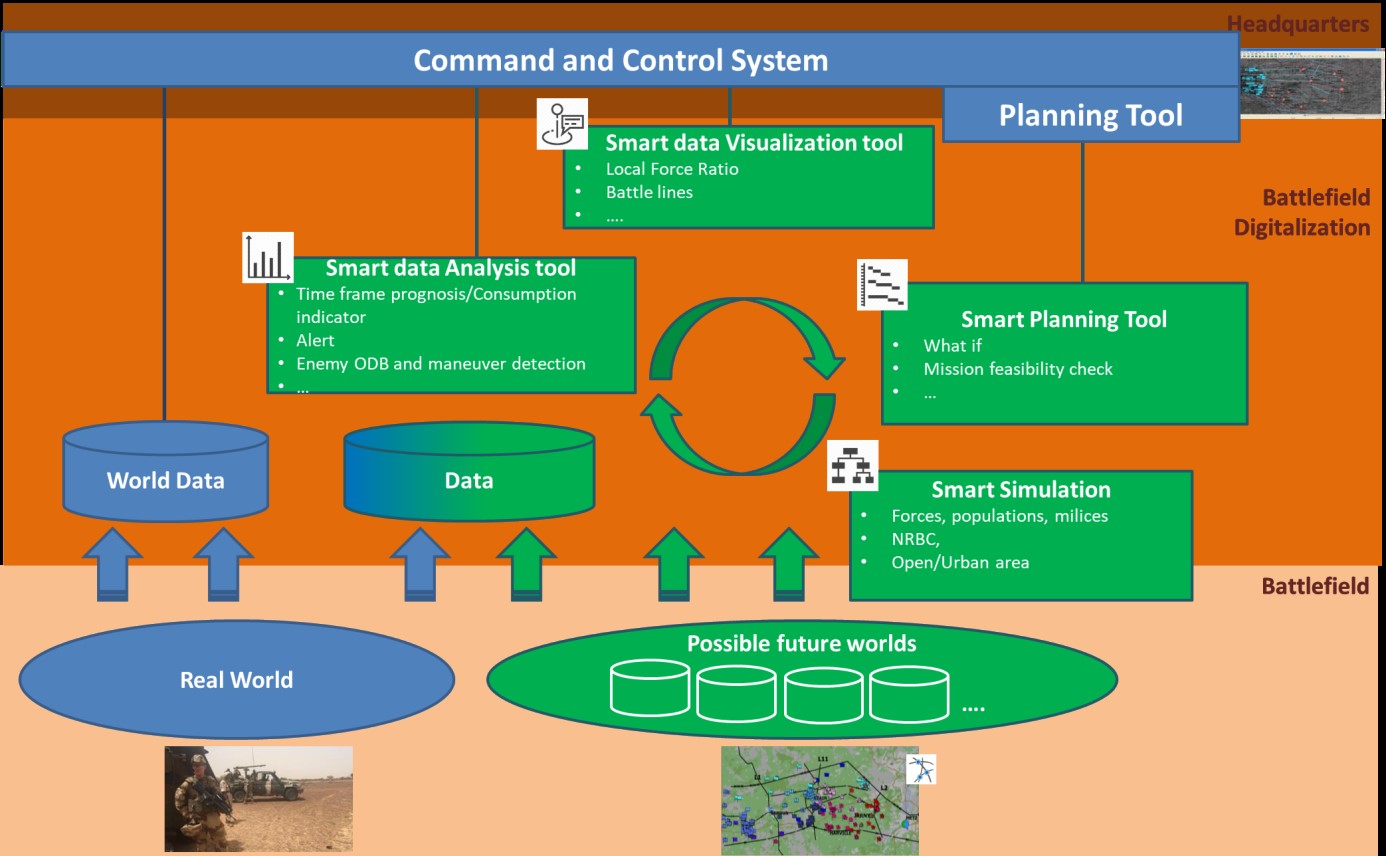Smart Simulation for Decision Support at Headquarters
Abstract
While serious games are being widely adopted by NATO and partner nations, their use is currently limited to training and operations planning. In this paper, we explore new methods that use simulations for decision support during the execution of military operations. During this phase, the commander makes decisions based on knowledge of the situation and the primary objectives. We propose here to take a simulation containing smart and autonomous units, and use it to create new kinds of decision support tools capable of improving situation awareness, and consequently the quality of decisions. The breakthrough behind this initiative is the realization that we can provide HQ decision makers with access to a version of the information that smart simulated units use to make decisions. To ensure the approach was sound we first studied decision-making processes, and analyzed how situation awareness improves decision making. After analysis of the decision-making processes at various headquarters, and the types of decision criteria employed, we are able to produce innovative information, computed by the simulation, and fed by the command and control system. We then propose a prerequisite architecture, and describe the first results of our proof of concept work based on the SWORD (Simulation Wargaming for Operational Research and Doctrine) simulation.
Based on the current situation (intelligence, operational state, logistics, etc.) and the current maneuver (current task), examples of what we are now capable of are as follows: provide an immediate local force ratio map, produce a capacities map (detection, combat), compute contextual fire or logistic support time required, automatically generate lines of battle such as the Forward Line of Own Troops (FLOT), Limit Of Advance (LOA), Line of Contact (LC), Forward Edge of Battle Area (FEBA), or propose an effect based maneuver map in order to understand the current effect of the forces on the ground. We then propose a prerequisite architecture for use as a decision-support system at HQ, and describe the next smart layers that we believe should be developed for optimal results.
References
Chen, M., Zhu, Q. M., & Chen, Zh. X. (2001). An Integrated Interactive Environment for Knowledge Discovery from Heterogeneous Data Resources. Journal of Information & Software Technology, 43(1). https://doi.org/10.1016/S0950-5849(01)00159-8
Davis, K. P., Kulick, J., & Egner, M. (2005). Implications of Modern Decision Science for Military Decision-Support Systems, Santa Monica: RAND Corporation, 2005.
Endsley. (1995). Toward a Theory of Situation Awareness in Dynamic Systems. In: Human Factors 37.1 (1995), 32-64. https://doi.org/10.1518/001872095779049543
Général Loup Francart, La maîtrise de l’information, Doctrines, 2000.
Christian, K. G., & Marco, C. M. (2016). Towards Game-based Management Decision Support: Using Serious Games to Improve the Decision Process. Retrieved from https://www.wiwi.uni-augsburg.de/bwl/meier/Download_Publikationen/Grund_Meier_2016_Towards_Game-based_Management_Decision_Support.pdf
Leifler, O. (2011). Affordances and Constraints of Intelligent Decision Support for Military Command and Control — Three Case Studies of Support Systems. Linköping University, 2011. Retrieved from http://www.diva-portal.org/smash/get/diva2:412065/FULLTEXT02.pdf
Maess. (1995). Artificial life meets entertainment: Life like autonomous agents. Communications of the ACM, 38(11), 108-114. https://doi.org/10.1145/219717.219808
Mora, M., Forgionne, G., Gupta, J., Cervantes, F., & Gelman, O. (2003). A framework to assess intelligent decision-making support systems. In: Knowledge-Based Intelligent Information and Engineering Systems, 59-65. https://doi.org/10.1007/978-3-540-45226-3_9
Plamen V. P., Zhu, Q. M., Jeffrey, D. H., & Alexander, D. S. (2002). A Hierarchical Collective Agents Network for Real-time Sensor Fusion and Decision Support. In AAAI Workshop Technical Report WS-02-15, Menlo Park: AAAI Press, 2002. Retrieved from https://www.aaai.org/Papers/Workshops/2002/WS-02-15/ WS02-15-009.pdf
Stuart, R., & Peter, N. (1995). Artificial intelligence: A modern approach. Prentice Hall, 1995.
Simon, H. A. (1965). Administrative behavior. Cambridge UnivPress,1965.
Andreas, T., & Dietmar, K. (2000). Decision Support Systems - Technical Prerequisites and Military Requirements. In 2000 Command and Control Research and Technology Symposium Proceeding, June 2000, Retreived from https://arxiv.org/abs/1011.5661
Boyd, John (1995). The Essence of Winning & Losing, 28 June 1995. Retrieved from http://www.danford.net/boyd/essence.htm


This work is licensed under a Creative Commons Attribution 4.0 International License.
Copyright for this article is retained by the author(s), with first publication rights granted to the journal.
This is an open-access article distributed under the terms and conditions of the Creative Commons Attribution license (http://creativecommons.org/licenses/by/4.0/).








1.png)














